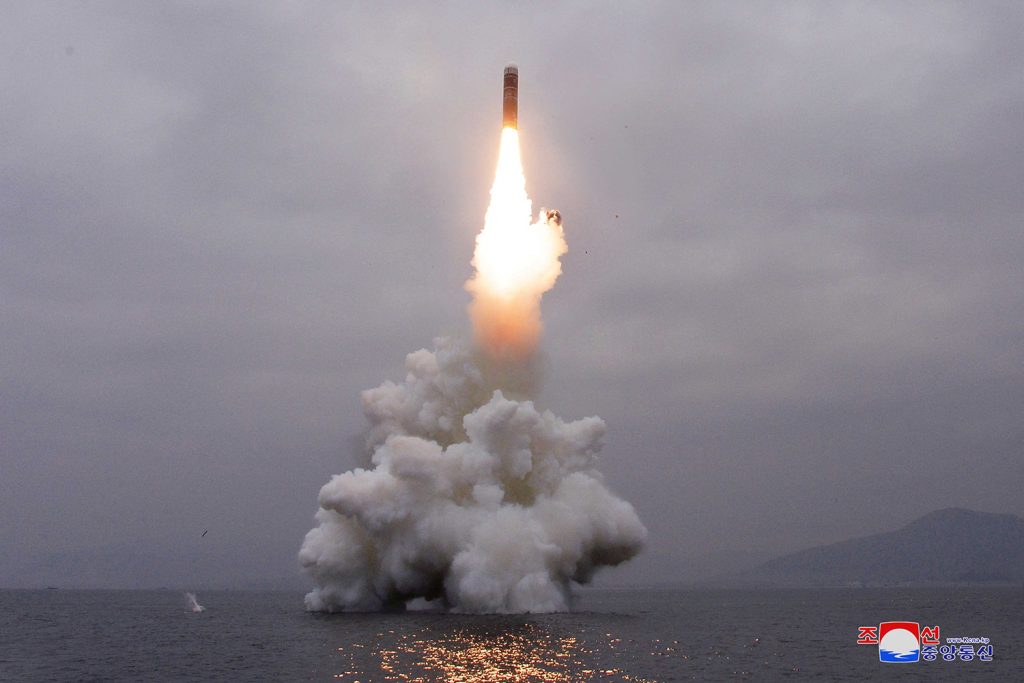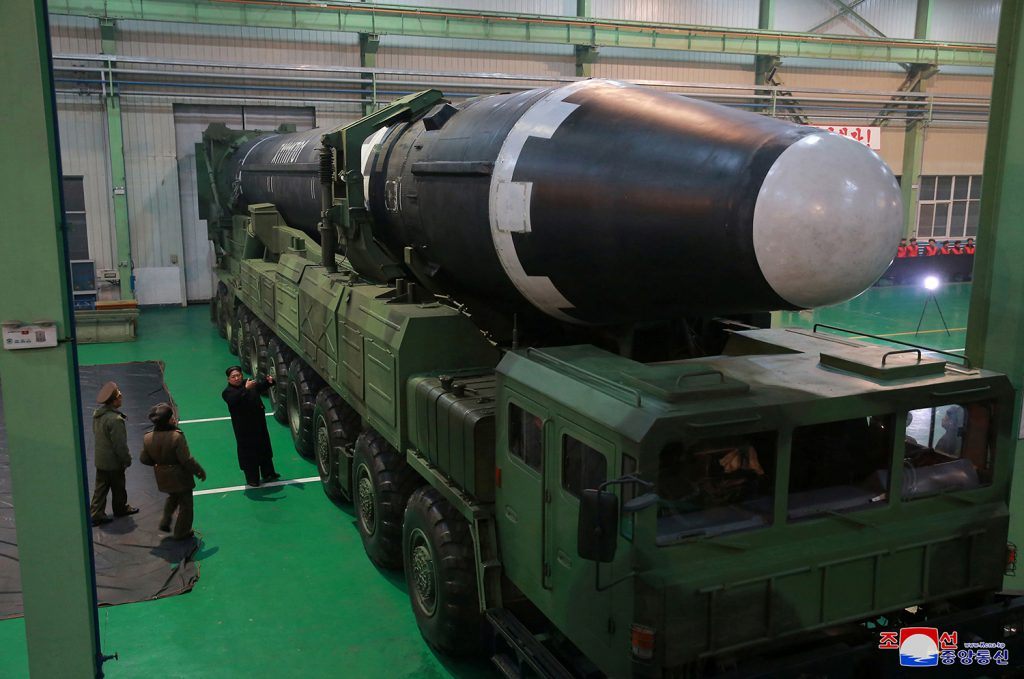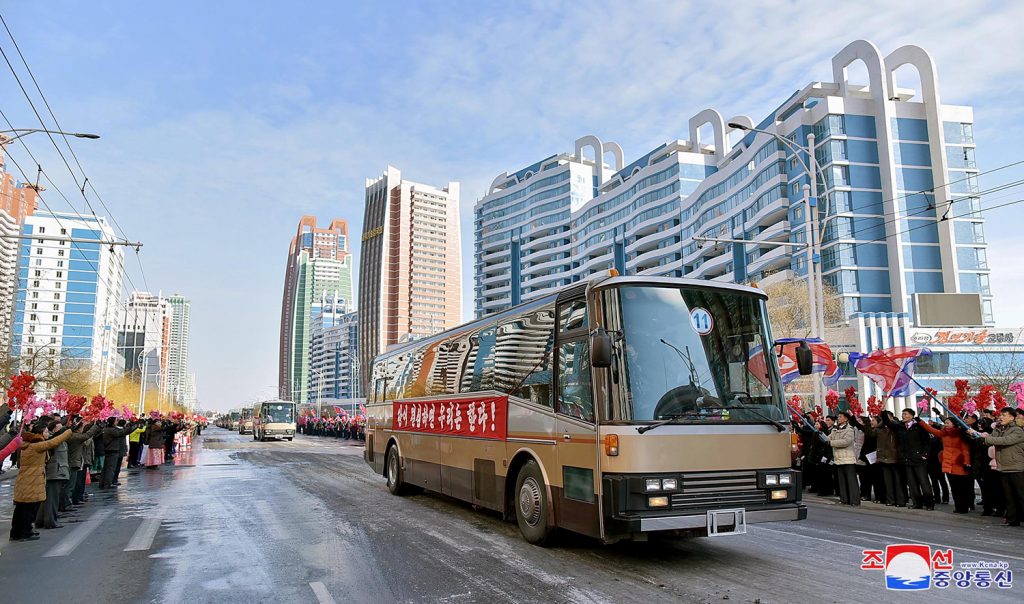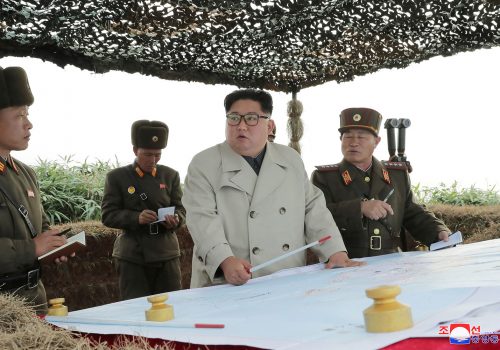October 1, 2020
What an ‘October surprise’ from North Korea might actually look like
Key Points
- Expect North Korea to display new strategic weaponry for the 75th anniversary of its ruling party on October 10
- Attention is focused on the development of submarine-launched ballistic missiles, but mobile land-based ballistic missiles are already a credible, advancing threat
- The US and South Korea should re-invigorate efforts to counter and prevent the testing of more sophisticated North Korean ballistic missiles
On January 1, North Korea’s ruling-party newspaper published the results of a meeting with ominous implications. Chairman Kim Jong Un had declared that the world would soon witness a new strategic weapon from North Korea and added that he no longer “felt bound” by his pledge to halt inter-continental ballistic missile (ICBM) launches and nuclear testing. Eight months have passed since this promise, but that does not mean a new strategic weapon is not coming—or that we should take his warnings lightly. And speculation that the “new strategic weapon” is a ballistic-missile submarine or submarine-launched ballistic missile itself distracts from the need to focus on a far more credible and urgent threat: North Korea’s rollout and test launches of more advanced road-mobile ballistic missiles.
In his 2017 New Year’s address, Kim asserted that North Korea was in the final stages of preparations for ICBM test launching, but it took until the July 4 holiday that year for North Korea to follow through and conduct its first Hwasong-14 ICBM launch. It was not until late November that North Korea launched an even larger ICBM, the Hwasong-15, with the accompanying claim that ICBM testing had been completed successfully. There are many potential reasons for the long period between North Korea’s announcement and launches in 2017, including its need to first complete preliminary test launches of the Hwasong-12, an intermediate-range missile that the Nuclear Threat Initiative assessed to be a “stepping stone” to an ICBM.
This year, by comparison, there are a myriad of potential reasons for the delay in carrying out Kim’s announcement besides just technical ones, including disruptions caused by COVID-19, summer typhoons, and political considerations: the upcoming US presidential election, a series of meetings of North Korea’s ruling Korean Workers’ Party, and the Party anniversary in October. Even if he is confident that his “new strategic weapon” will work, Kim may be waiting for just the right political moment to display it and then to launch it. If he offers up an “October surprise” this year, it probably won’t be the North Korean version of the fictional Soviet ballistic-missile submarine “Red October.” Instead, it may well come in the form of new missiles displayed on the streets of Pyongyang during the Party’s 75th anniversary parade.
A submarine armed with a few ballistic missiles is hardly a ‘new strategic weapon‘
There is reason for skepticism about the speculation, primarily in the South Korean press, about the “new strategic weapon” being a ballistic-missile submarine (a submarine fitted with vertical launch tubes for ballistic missiles). Though journalists and experts have repeatedly pointed to indications of work on a ballistic-missile submarine and submarine-launched ballistic missiles (SLBMs), this has garnered disproportionate attention among Korea watchers and does not constitute sufficient evidence that Kim was referring in his January statement to something submarine-related.
A submarine, of course, makes for a better story—with flashier graphics and better headlines—than yet another North Korean road-mobile missile. And the publicly available analysis on North Korean strategic capabilities favors submarines and SLBMs because that is what there has been to see lately. Activity at North Korea’s Sinpo submarine yard is visible in open-source imagery in a way that many activities in the “hard target” of North Korea are not, so it is reported on more vividly and frequently. A September 4 article from the Center for Strategic and International Studies’ “Beyond Parallel” site, for example, identified activities at Sinpo potentially associated with preparations for an SLBM test, quickly triggering a sharp and very public debate over the significance of these developments.

North Korea has previously called a ballistic-missile submarine a “strategic weapon,” but this term has much more often been used to refer to large, nuclear-capable ballistic missiles. If Kim was referring to a ballistic-missile submarine or a missile launched from one, calling it a “new strategic weapon” probably just amounts to North Korean hyperbole. North Korea already tested a new model of submarine-launched ballistic missile last October, and gave us glimpses of what a number of analysts believe is a submarine being converted to fire ballistic missiles. So even if this is the strategic weapon Kim was referring to, it is not really that “new.” The SLBM program has been slowly making progress for years. As the US Department of Defense reported, North Korea first fired a ballistic missile from a submerged submarine as far back as August 2016.
Adding an outdated ballistic-missile submarine with limited capabilities to North Korea’s force would also not change the strategic equation significantly, particularly not relative to its cost. As Vann Van Diepen, a former US National Intelligence Officer for Weapons of Mass Destruction, and others have explained, the submarine in question would probably add only a few additional launch tubes to North Korea’s ballistic missile force, meaning little for either the survivability or offensive power of North Korea’s arsenal. Given that North Korea’s imports of electronics, machinery, and metals have been so severely restricted by UN sanctions, how could the most efficient use of that precious material be to funnel so much into one large submarine?
Road-mobile missiles are North Korea’s strategic deterrent force
In contrast to its nascent, largely unproven, and resource-intensive ballistic-missile submarine capability, North Korea’s mobile land-based ballistic missiles pose a much more advanced, mature, and resource-efficient threat. North Korea has been producing and test-launching land-based mobile ballistic missiles since the 1980s. Just since Kim took power at the end of 2011, North Korea has test-launched over a hundred ballistic missiles, all but a handful of them road-mobile, rather than submarine-launched types.
Though some speculate that North Korean submarine-launched missiles would grant North Korea a “second strike” capability that could survive a first strike by any adversary and thereby guarantee North Korean nuclear retaliation, this thinking appears to be based on inappropriately applying the historical analogy of the Cold War nuclear superpowers. The United States and Soviet Union could rest their deterrent credibility upon a “second strike” from a robust force of nuclear-powered ballistic-missile submarines that could conduct lengthy submerged cruises, evade detection, and deliver nuclear warheads to their adversary’s homeland even if their own homeland were destroyed. Given North Korea’s resource limitations and the challenges involved in developing such a capability, it is likely a long way from the ability to produce even a single nuclear-powered submarine—much less the infrastructure and expertise necessary to engineer, build, train, and operationally deploy a submarine force capable of continuously holding the continental United States at risk.
The credibility of North Korea’s “second strike” could rest instead on numerous land-based missiles fired from mobile launchers. This setup is much more practical than building up a large, advanced ballistic-submarine fleet, and takes advantage of North Korea’s terrain. Mobile targets like missile launchers, already notoriously hard to track even in a desert, would be harder to find in North Korea’s mountainous terrain and numerous underground facilities.
Furthermore, submarines, which rely on stealth and independent operations, would pose a much more challenging command-and-control-problem for North Korea than land-based launchers that can more easily remain in continuous communication. As various analysts, including Ankit Panda, the author of Kim Jong Un and the Bomb, have noted, with the technology that is likely available to North Korea, there isn’t a foolproof way to both eliminate the risk of unauthorized launch from a submarine and ensure a second-strike capability.
With all this in mind, Kim is almost certain to continue to rely on and reinforce his increasingly capable and diverse land-based, nuclear-capable mobile missile force as the core of his strategic deterrent. That being the case, it is worth exploring what new types of land-based missiles he might field.
More warheads, more problems
The most important type of truly “new strategic weapon” for North Korea would likely be a large road-mobile ballistic missile with the ability to deliver multiple re-entry vehicles (RVs). (Re-entry vehicles are carried at the top of a ballistic missile, detaching after the missile ascends to carry and protect a warhead as it travels to its target from space through atmospheric re-entry.) This scenario has received far less attention than a ballistic-missile submarine, even though a member of the Intelligence Committee of South Korea’s legislature has commented on the possibility and experts have long noted multiple RVs as a logical future step for North Korea’s weapons development.
A ballistic missile with multiple RVs would pose at least three major problems for the US-South Korea alliance that a ballistic-missile submarine would not.
- North Korea could quickly expand the number of warheads it could deliver even if it is only able to produce a few missiles at a time, a key consideration if sanctions have been effective in limiting North Korea’s access to the materials necessary to build missiles.
- Multiple RVs could boost the credibility of North Korea’s deterrent by overcoming skepticism about the accuracy and reliability of North Korea’s RVs, since they would give each missile multiple chances for a successful hit.
- Perhaps most importantly, North Korea’s fielding of an ICBM with multiple warheads would make it much more complicated, and possibly impractical, for the US military to intercept a North Korean missile attack on the continental United States. During the Cold War, the advent of multiple warhead ICBMs caused many experts to conclude that interceptor missiles could not be a practical or cost-effective defense for the continental United States. This is what eventually led to the Reagan administration’s focus on new counter-missile technologies like space-based lasers under the Strategic Defense Initiative, colloquially known as “Star Wars.”
General John Hyten, vice chairman of the Joint Chiefs of Staff, recently commented that he has “one hundred percent confidence” in the ability of US ground-based missile-defense interceptors launched from Alaska and California to stop a North Korean attack on the US homeland. This level of confidence poses a strategic problem for North Korea that a plausible new ballistic-missile submarine could not address, and counters North Korea’s 2017 claims that its test-launches had proven its ability to strike all of the United States. The value of North Korea’s ICBMs for deterrence and leverage is contingent on threatening the continental United States, so their value is virtually nullified by clear US confidence in its missile defense of the homeland.

If North Korea fields ICBMs with multiple warheads, however, this could be an effective countermeasure to undermine confidence in US missile defenses and overcome skepticism about North Korea’s RVs. It is hard to see how Americans could be confident that a finite number of US missile-defense interceptors would be sufficient to stop an attack by a volley of North Korean ICBMs with multiple warheads each. Even if the United States were to attempt to build more interceptors to keep up, the costs could be prohibitive.
What surprises do the North Koreans have in mind for October?
As the US presidential election approaches, speculation has been rife about the potential for an unpleasant “October surprise” from North Korea, and with good reason. It would not be a surprise, necessarily, if North Korea test-launched a more advanced strategic solid-fuel missile or even a large new missile with multiple warheads. That said, ahead of the election Kim seems to be hedging his bets when it comes to his relationship with the US president, and Kim’s sister went as far as to publicly state that North Korea would refrain from any “threatening” actions toward the United States through the election period.
It is far more likely that North Korea will take advantage of the large military parade that would be traditional for the 75th anniversary of the Korean Workers’ Party, on October 10, to display road-mobile missile systems without going so far as to be unnecessarily provocative to a US president with whom Kim has cultivated a special, “personal relationship” according to North Korean state media. The 2015 parade for the Party’s 70th anniversary featured a variety of ballistic missiles, so we would expect to see a similar variety of types, along with more advanced new types, including one or more kinds of “new strategic weapon” ready for testing as soon as the political moment is right for Kim. Though some observers are concerned about a potential solid-fuel ICBM being unveiled on October 10, such a system is more likely to be a mockup than ready to test. There should be more worry about reports from NK News, 38 North, and other outlets that North Korea appears to be preparing infrastructure to parade larger, heavier systems, and to display many more launchers than in previous years—indicating not just a qualitative increase in the threat, but also a quantitative one.

That said, if North Korea were to launch a ballistic-missile submarine or SLBM in the coming months, timing this on or near the October anniversary would also make sense, so these possibilities are not mutually exclusive. Given North Korea’s track record and Kim’s statement, it would be more of a surprise if the North Koreans did not display any new strategic weapons systems in October.
Focusing on what matters
Ultimately, an emerging North Korean SLBM capability should not draw too much focus as the South Korea-United States alliance is already moving in a direction that will counter this threat much faster than the threat will grow. Anti-submarine warfare is an area where the United States and South Korea already have a competitive advantage, a huge technological head start, and continuing strong investments. A new North Korean ballistic-missile submarine can be addressed without major new efforts on the part of the alliance. In contrast, countering North Korea’s growing arsenal of land-based mobile ballistic missiles, particularly if new missiles carrying multiple warheads are added to the mix, will require focused new political, technological, financial, and intellectual investments by the South Korea-United States alliance.
First, from a military perspective, the alliance should re-invigorate efforts to both develop and publicly highlight its capabilities, tactics, techniques, procedures, and plans to comprehensively counter the primarily land-based North Korean missile threat using the “4D” (detect, defend, disrupt, destroy) approach first unveiled in 2013 and repeatedly referenced at high levels through 2017. South Korea, for its part, has continued to highlight its own counter-missile efforts, renaming them last year as the “three axis system” including “overwhelming response,” “strategic target strike,” and “Korea-style missile defense.” Meanwhile, bilateral alliance efforts on countering North Korean missiles appear to have moved to the back burner. Readouts from the last two Security Consultative Meetings—annual formal sessions led by the US Secretary of Defense and his South Korean counterpart—mention neither an alliance “counter-missile” effort nor “4D” itself, despite those terms appearing in annual communiques from 2013 to 2017.
Simply because a phrase does not appear in a meeting readout does not mean that nothing is being done, but these high-level meetings help to both set and reflect alliance priorities internally and externally, meaning that the absence of counter-missile efforts from the communique is not a good sign. Countering North Korea’s advancing ballistic-missile capabilities, both narratively and concretely, should be a major priority for the alliance that is reflected in the next bilateral defense meeting.
Secondly, from a political perspective, the alliance must be prepared with a strong response to any additional North Korean displays or testing of strategic weapons, including road-mobile missiles. More importantly, even the display or announcement of a new missile with multiple-warhead capability must draw a strong response from the United States and the international community, ideally to deter the flight testing that would allow for the refinement and fielding of such a capability. Failing that, every reasonable effort must be made to give North Korea an incentive not to conduct further ballistic-missile flight testing, and to prepare to impose additional costs if North Korea presses forward regardless. If North Korea can field such systems with impunity, it will probably make Pyongyang even more confident—and therefore harder to counter and contain.
The views expressed in this article are those of the authors and do not imply endorsement by the Office of the Director of National Intelligence or any other US Government agency.
Markus Garlauskas served as the National Intelligence Officer for North Korea, leading the US intelligence community’s strategic analysis of North Korea from 2014 to 2020. Before his term as a member of the Senior National Intelligence Service concluded in June 2020, he served for nearly twenty years in the US government, including almost twelve years in Seoul on the staff of US Forces Korea. He is a nonresident senior fellow with the Scowcroft Center’s Asia Security Initiative at the Atlantic Council, and tweets at @Mister_G_2.
Bruce Perry served as the Senior Intelligence Officer for Northeast Asia Division, US Indo-Pacific Command, 2005-2019, before his retirement from US government civilian service. During his tenure, he was temporarily assigned as Deputy Chief, Multi-national Intelligence Support Element, the team which helped to conclude that a North Korean submarine was responsible for the 2010 sinking of the South Korean warship Cheonan. He began his government civilian service after his retirement from the US Army after a total of twenty-five years of military service in the US Army and Navy—including service as an intelligence officer in US Forces Korea, and in combat as a tank platoon leader in Desert Storm.
Further reading:
Image: North Korean leader Kim Jong-Un (C) visits the Wolnae Islet Defence Detachment in the western sector of the front line, which is near Baengnyeong Island of South Korea March 11, 2013 in this picture released by the North's official KCNA news agency in Pyongyang March 12, 2013. REUTERS/KCNA


